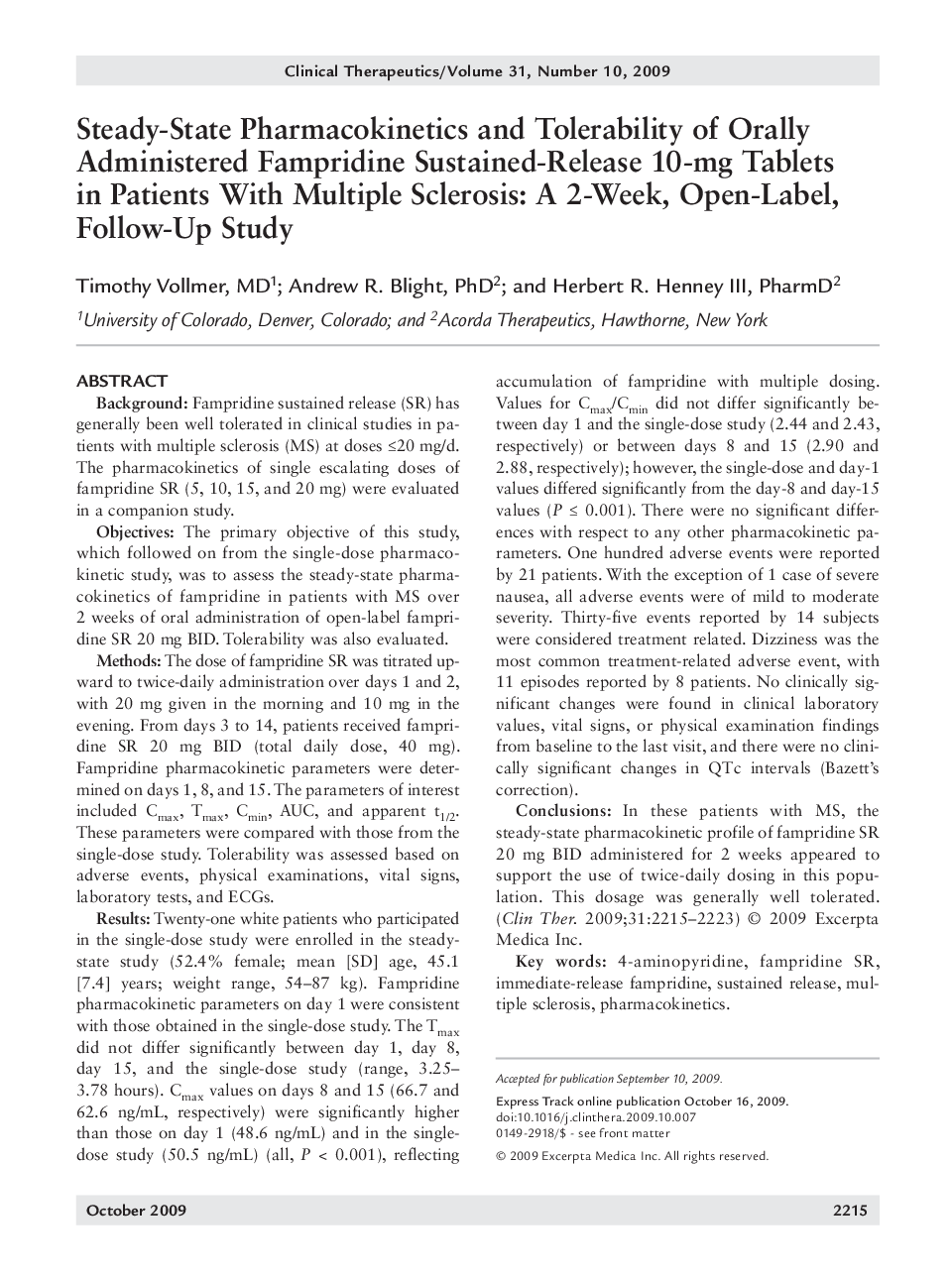| کد مقاله | کد نشریه | سال انتشار | مقاله انگلیسی | نسخه تمام متن |
|---|---|---|---|---|
| 2528303 | 1119963 | 2009 | 9 صفحه PDF | دانلود رایگان |

Background: Fampridine sustained release (SR) has generally been well tolerated in clinical studies in patients with multiple sclerosis (MS) at doses ≤20 mg/d. The pharmacokinetics of single escalating doses of fampridine SR (5, 10, 15, and 20 mg) were evaluated in a companion study.Objectives: The primary objective of this study, which followed on from the single-dose pharmacokinetic study, was to assess the steady-state pharmacokinetics of fampridine in patients with MS over 2 weeks of oral administration of open-label fampridine SR 20 mg BID. Tolerability was also evaluated.Methods: The dose of fampridine SR was titrated upward to twice-daily administration over days 1 and 2, with 20 mg given in the morning and 10 mg in the evening. From days 3 to 14, patients received fampridine SR 20 mg BID (total daily dose, 40 mg). Fampridine pharmacokinetic parameters were determined on days 1, 8, and 15. The parameters of interest included Cmax, Tmax, Cmin, AUC, and apparent t½ These parameters were compared with those from the single-dose study. Tolerability was assessed based on adverse events, physical examinations, vital signs, laboratory tests, and ECGs.Results: Twenty-one white patients who participated in the single-dose study were enrolled in the steadystate study (52.4% female; mean [SD] age, 45.1 [7.4] years; weight range, 54–87 kg). Fampridine pharmacokinetic parameters on day 1 were consistent with those obtained in the single-dose study. The Tmax did not differ significantly between day 1, day 8, day 15, and the single-dose study (range, 3.25–3.78 hours). Cmax values on days 8 and 15 (66.7 and 62.6 ng/mL, respectively) were significantly higher than those on day 1 (48.6 ng/mL) and in the singledose study (50.5 ng/mL) (all, P < 0.001), reflecting accumulation of fampridine with multiple dosing. Values for Cmax/Cmin did not differ significantly between day 1 and the single-dose study (2.44 and 2.43, respectively) or between days 8 and 15 (2.90 and 2.88, respectively); however, the single-dose and day-1 values differed significantly from the day-8 and day-15 values (P ≤ 0.001). There were no significant differences with respect to any other pharmacokinetic parameters. One hundred adverse events were reported by 21 patients. With the exception of 1 case of severe nausea, all adverse events were of mild to moderate severity. Thirty-five events reported by 14 subjects were considered treatment related. Dizziness was the most common treatment-related adverse event, with 11 episodes reported by 8 patients. No clinically significant changes were found in clinical laboratory values, vital signs, or physical examination findings from baseline to the last visit, and there were no clinically significant changes in QTc intervals (Bazett's correction).Conclusions: In these patients with MS, the steady-state pharmacokinetic profile of fampridine SR 20 mg BID administered for 2 weeks appeared to support the use of twice-daily dosing in this population. This dosage was generally well tolerated.
Journal: Clinical Therapeutics - Volume 31, Issue 10, October 2009, Pages 2215-2223